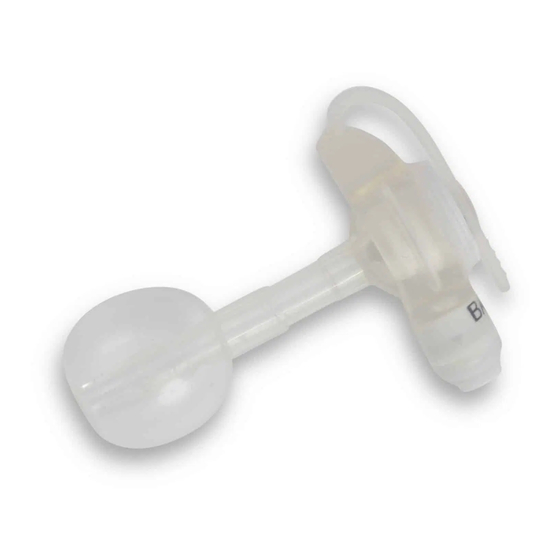Table of Contents
Advertisement
Advertisement
Table of Contents

Summary of Contents for Halyard MIC-KEY
- Page 1 MIC-KEY G FEEDING TUBE YOUR GUIDE TO PROPER CARE...
-
Page 3: Table Of Contents
- The MIC-KEY Extension Set - The MIC-KEY Bolus Extension Set - The Syringes CARE AND USE - Maintenance of the MIC-KEY G Feeding Tube FEEDING THROUGH THE MIC-KEY FEEDING TUBE - Proper Placement - Residual - Decompression or Venting... -
Page 4: Introduction To Tube Feeding
This tube allows the intake of food and water that your body requires. Clamp Your specialist has measured you to ensure that you have the right size MIC-KEY feeding tube. You also received care and maintenance instructions. This pamphlet will help you... -
Page 5: The External Base
A good fit is considered one-eighth inch (3 mm) above the skin, or approximately the thickness of a dime. THE MIC-KEY FEEDING PORT Nourishment and liquids are delivered through the gastrostomy tube and into the stomach through the feeding and medication port. -
Page 6: The Balloon Valve
It should only be used when checking the balloon volume or Medication Port replacing the MIC-KEY . It is important to never attempt to feed through the balloon valve. It is also important to keep this valve clean. The recess in the valve can trap foreign material and it must be clean to function properly. -
Page 7: The Syringes
A 6 ml luer slip syringe is included with your feeding tube kit. Use it to inflate and deflate the retention balloon when periodically checking its volume and when you replace the MIC-KEY feeding tube. Your MIC-KEY feeding tube kit also includes a 35 ml catheter tip syringe. -
Page 8: Maintenance Of The Mic-Key
Never allow a wet dressing to remain in contact with the skin. Note: The MIC-KEY feeding tube does not require a dressing. Gently clean the skin around the stoma. Rotate the MIC-KEY feeding tube and clean again. -
Page 9: Residual
If you still do not hear it, do not proceed to feed. Contact the specialist and report the problem. RESIDUAL Another advantage of the MIC-KEY feeding tube is the ability to measure stomach residual without a decompression tube. Residual is the amount of gastric fluid and formula left in the stomach four hours after feeding. -
Page 10: Continuous Feeding
(If using powdered formula, it should line on the extension set. Gently detach the be prepared fresh every day. Refer to the extension set and cap the MIC-KEY feeding information section of this booklet for the tube securely with the attached feeding prescribed amount. -
Page 11: Bolus Feeding
11. Flush the bolus extension set tubing with 1. Attach a water filled catheter tip syringe to 10–20 ml’s of warm water or until the the MIC-KEY bolus extension set. Prime the extension set by filling it with water. tubing is clear. -
Page 12: Medications
DO NOT 5. Lubricate the tip of the replacement MIC-KEY USE OIL OR PETROLEUM JELLY. 6. Gently guide the new tube into the stoma. Insert the tube all the way until the MIC-KEY feeding tube is flat against the skin. -
Page 13: Children's Corner
CHILDREN’S CORNER Children are special and they have special needs. If you are caring for a child with a gastrostomy, the following points may help. CHILDREN HAVE SMALL STOMACHS Infants develop the capacity to hold large feedings in their stomachs as they grow. Feedings usually begin with frequent small amounts of formula. -
Page 14: Problem Solving
2 ml at a time until the leak stops. The maximum fill volume is 10 ml’s (5 ml for 12 French sizes). Do not exceed this. CAUTION: USE CARE WHILE FILLING OR REMOVING WATER FROM THE BALLOON. THE MIC-KEY FEEDING TUBE MAY EASILY BE PULLED OUT. - Page 15 BALLOON LEAKS OR RUPTURES Always keep a replacement MIC-KEY feeding tube or conventional gastrostomy tube at home. Silicone balloons generally last several months, but the life span of the balloon varies according to several factors.
- Page 16 Redness or soreness around the skin and stoma may be the result of gastric leakage. Clean and dry the area frequently. Be sure to rotate the MIC-KEY feeding tube in a full circle during daily tube care. CALL THE SPECIALIST IF: 1.
-
Page 17: Special Children's Problems
SPECIAL CHILDREN’S PROBLEMS IF A CHILD VOMITS When vomiting occurs, it is possible to inhale formula and stomach contents into the lungs. Aspiration is the medical term for this and it can lead to serious medical problems. If a child develops difficulty breathing during or immediately after a feeding, STOP THE FEEDING AT ONCE, DRAIN (DECOMPRESS) THE STOMACH AND CALL THE SPECIALIST. -
Page 18: Glossary Of Terms
GLOSSARY OF TERMS ASPIRATION: Accidentally inhaling liquid into the windpipe and/or lungs. BOLUS FEEDING: Large amounts of formula delivered through the tube. CONSTIPATION: Bowel movements (stools) sometimes painful, and difficult to pass. CONTINUOUS FEEDING: Small amounts of formula constantly throughout the day (or night) without interruption. - Page 19 Follow the doctor’s instructions Flush with ________ ml water before and after every feeding Mix well and refrigerate. Follow specialist’s instructions IF YOU HAVE ANY QUESTIONS ABOUT YOUR MIC-KEY FEEDING TUBE, YOU MAY CALL HALYARD HEALTH TOLL FREE AT 1-844-HALYARD (1-844-425-9273).
- Page 20 Halyard Health, Inc., 5405 Windward Parkway, Alpharetta, GA 30004 USA Halyard Belgium BVBA, Leonardo Da Vincilaan 1, 1930 Zaventem, Belgium Sponsored in Australia by Halyard Australia Pty Limited; 52 Alfred Street, Milsons Point, NSW 2061 製造販売元 ハリヤー ド ・ ヘルスケア ・ イ ンク 横浜市西区みなとみら い二丁目2番1号...













Need help?
Do you have a question about the MIC-KEY and is the answer not in the manual?
Questions and answers